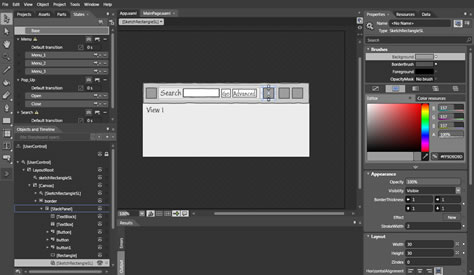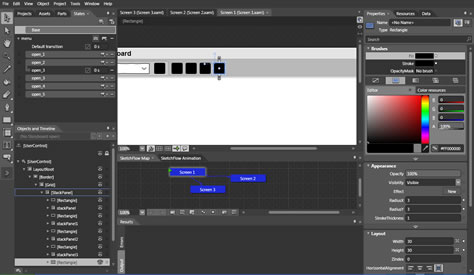
The Sketchflow module adds two panels to Blend, Sketchflow Map and Sketchflow Animation, as shown in Figure 2. Sketchflow Map lets you create and link screens and reusable components. Sketchflow Animation lets you create animations in a storyboard fashion. It is a simplification of functionality that is already in Blend. There are a couple of other slight differences. I’m not sure why it’s even a separate module.

My experience using Blend has led to me to reevaluate not only how I design, but also what I deliver at the end of the design process. As I began to use Sketchflow, I seriously wondered whether I would ever create a static wireframe again. Why bother when I could quickly create dynamic, digital sketches that become working prototypes with a click of a button? For the first time in a long while, I truly felt connected to the applications I was designing. I wasn’t jumping through hoops to feel the behavior I was designing. I was knee deep in it, shaping and molding it as I iterated through various design problems.
Before my enthusiasm gets the best of me, it is very important to recognize that Blend is only a tool. It can be a powerful addition to an interaction designer’s tool chest. But just as producing wireframes should not be the sole focus of your design process, neither should the creation of deliverables using Blend. Dan Brown, author of Communicating Design and principal at Eight Shapes, recently reminded me that, “At the end of the day, we’re all just making abstractions, representations of things users will ultimately see and touch.” It does not matter which tools we use to create these abstractions. What really matters is our rigorous exploration of design possibilities, effective demonstration of our design intent, and the meaningful documentation of our design solutions.
Exploration of Design Solutions
Design is inherently iterative. In Sketching User Experiences, Bill Buxton describes design as a process of elaboration and reduction, as well as choice. Interaction designers apply their creativity to the design process while “enumerating meaningful, distinct options” and “defining the criteria, or heuristics, according to which you make your choices.” (For an interesting take on defining the criteria, see Luke Wroblewski’s presentation “Parti & the Design Sandwich.”![]() ) Thanks to Buxton and many others, sketching has become engrained in the interaction designer’s psyche as the tool of choice for exploration. It is easy to explore a myriad of options with a pencil and some paper.
) Thanks to Buxton and many others, sketching has become engrained in the interaction designer’s psyche as the tool of choice for exploration. It is easy to explore a myriad of options with a pencil and some paper.
However, sketching is really a mindset. Sketches do not have to be hand rendered. You can just as easily sketch digitally. I have created lo-fi wireframes, or digital sketches, using Visio or OmniGraffle for years. Regardless of how you create your sketches, they need to be disposable, timely, and plentiful. You have to be willing to throw them away. An advantage to digital sketches is that you can more readily mimic dynamic behavior to see how an interaction feels. Buxton gives numerous examples of how you can easily make a static sketch dynamic in his book. Using Blend, I can easily create dynamic sketches. But at what point does a sketch verge on becoming a prototype?
Buxton makes a succinct distinction between sketching and prototyping. Sketches are noncommittal and tentative. They let you suggest, explore, and question. Conversely, prototypes are specific depictions that allow you to describe, refine, and test your design solutions. So, prototypes are refined demonstrations of your design intent. A prototype can be many things, whether digital or on paper. One thing is for certain, creating a prototype typically requires a much greater time investment than sketching does, because you focus less on exploring options and spend more time refining details.
As you refine the details of a design, you’ll most likely become increasingly married to that design. This is a potential pitfall of using a tool like Blend. You can easily dive too deeply into refining your design when you really should still be sketching. I know this from experience. Blend tries to alleviate this tendency through its Sketchflow module, which offers styles that mimic hand-drawn sketches, including handwritten fonts—one is aptly named Buxton. This helps you to think with a sketching mindset. Peter Parker’s uncle said it best, “With great power, comes great responsibility!”
